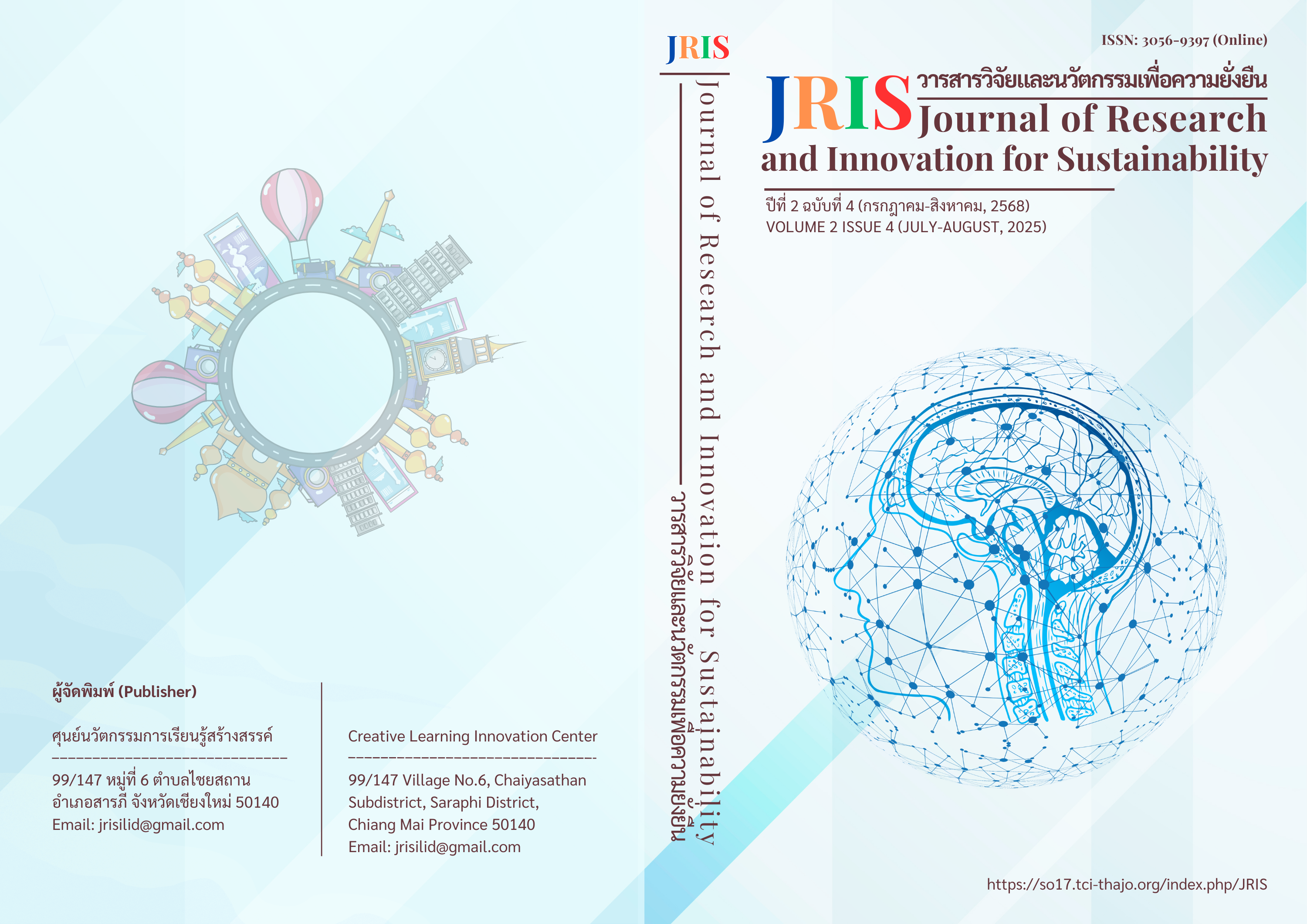THE DEVELOPMENT OF SELF-LEARNING ADAPTIVE MULTIMEDIA USING ADAPTIVE LEARNING TECHNIQUE ON SAFE TECHNOLOGY USAGE FOR MATHAYOMSUKSA 1 STUDENTS AT BAN DUEA DON KLANG SCHOOL (PRACHA SONGKHRO)
Main Article Content
Abstract
Development of Self-learning Adaptive Multimedia Using Adaptive Learning Techniques on Safe Technology Use for Mathayom 1 Students at Ban Duea Don Klang School (Pracha Songkhro) Research Objectives: 1. To develop self-learning adaptive multimedia using Adaptive Learning techniques on safe technology use for Mathayom 1 students at Ban Duea Don Klang School (Pracha Songkhro) with an efficiency criterion of 80/80 2. To compare learning achievement before and after using the self-learning adaptive multimedia among Mathayom 1 students 3. To study the satisfaction of Mathayom 1 students toward learning with self-learning adaptive multimedia. The target group used in this research consisted of 22 Mathayom 1 students selected by cluster random sampling. Research instruments included: 1) Self-learning multimedia, 2) Multimedia learning management plans, 3) Learning achievement tests, and 4) Student satisfaction questionnaire. Research Results:
1. The self-learning adaptive multimedia using Adaptive Learning techniques achieved an efficiency of 83.30/81.06, which is higher than the standard criterion of 80/80
2. Students' learning achievement after using the multimedia was significantly higher than before learning at the .05 statistical level
3. Students showed high satisfaction with the multimedia (M = 4.41, SD = 0.37)
Article Details

This work is licensed under a Creative Commons Attribution-NonCommercial-NoDerivatives 4.0 International License.
Copyright License
Permission is granted to use text, content, images, or any other material from the publication for anyone who wishes to read, download, copy, distribute, print, search, or link to the full text of the article, compile data for indexing, transfer data to software, or use for any other legal purposes, provided that it is not used for commercial purposes or for business benefit. All articles published in the Journal of Research and Innovation for Sustainability are distributed under a Creative Commons Attribution-NonCommercial-NoDerivatives 4.0 International License: https://creativecommons.org/licenses/by-nc-nd/4.0/
References
Anderson, J., & Williams, R. (2023). Digital technology usage patterns among Thai youth: A longitudinal study. Journal of Youth Studies, 26(4), 512–528.
Chen, X., & Liu, Y. (2022). Adaptive learning systems: Current trends and future directions. International Journal of Educational Technology, 9(3), 112–128.
Mitchell, R., Smith, T., Brown, K., & Lee, H. (2023). Artificial intelligence in adaptive learning: A systematic review. Computers & Education, 179, 104482.
Prensky, M. (2021). Digital natives, digital immigrants: A decade later. On the Horizon, 29(3), 1–8.
Zhang, L., Wang, J., Chen, Y., & Zhao, Q. (2023). The effectiveness of adaptive learning systems in secondary education: An experimental study. Educational Technology Research and Development, 71(3), 825–844.
ปรัชญาภรณ์ แพนพันธุ์อ้วน. (2567). การพัฒนาสื่อดิจิทัลออนไลน์ร่วมกับการจัดการเรียนรู้แบบนำตนเอง รายวิชาเทคโนโลยี (วิทยาการคำนวณ) สำหรับชั้นมัธยมศึกษาปีที่ 2 โรงเรียนสงวนหญิง จังหวัดสุพรรณบุรี. วารสารวิทยาศาสตร์และเทคโนโลยี มทร. สุวรรณภูมิ, 8(1), 41-52.
พฤฒภณ วุฒิสุข และภานุวัฒน์ ศรีไชยเลิศ. (2565). การพัฒนาบทเรียนออนไลน์ร่วมกับเทคนิคการเรียนรู้ด้วยตนเอง เรื่องการเขียนโปรแกรมด้วยภาษาไพทอน รายวิชาวิทยาการคำนวณ สำหรับนักเรียนชั้นมัธยมศึกษาปีที่ 1 โรงเรียนมัธยมฐานบินกำแพงแสน. Journal of Kanchanaburi Rajabhat University, 11(2), 300–314.
วิมลรัตน์ สุนทรโรจน์ และคณะ. (2566). การศึกษาพฤติกรรมการใช้อินเทอร์เน็ตของนักเรียนระดับมัธยมศึกษาตอนต้น. วารสารศึกษาศาสตร์, 34(2), 45–58.
ศักรินทร์ ปันชัย อาชานนท์ บัวหลวง และศิริกรณ์ กันขัติ์. (2566). การพัฒนาบทเรียนอิเล็กทรอนิกส์ เรื่อง แนวคิดเชิงคำนวณ. วารสารวิทยาศาสตร์และเทคโนโลยีสู่ชุมชน, 1(2), 36–45.
สถาบันวิจัยและพัฒนาแห่งมหาวิทยาลัยสุโขทัยธรรมาธิราช. (2556). คู่มือการวิจัยทางการศึกษา. มหาวิทยาลัยสุโขทัยธรรมาธิราช.
สำนักงานคณะกรรมการดิจิทัลเพื่อเศรษฐกิจและสังคมแห่งชาติ. (2565). รายงานสถานการณ์ภัยคุกคามทางไซเบอร์และแนวทางการป้องกัน. กระทรวงดิจิทัลเพื่อเศรษฐกิจและสังคม.
สำนักงานพัฒนาธุรกรรมทางอิเล็กทรอนิกส์. (2566). รายงานผลการสำรวจพฤติกรรมผู้ใช้อินเทอร์เน็ตในประเทศไทย ปี 2566. กระทรวงดิจิทัลเพื่อเศรษฐกิจและสังคม.
สำนักงานเลขาธิการสภาการศึกษา. (2566). รายงานการติดตามและประเมินผลการดำเนินงานตามแผนการศึกษาแห่งชาติ พ.ศ. 2560–2579. กระทรวงศึกษาธิการ.

